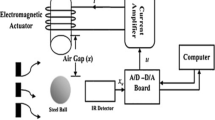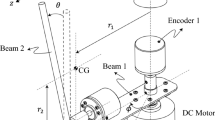Abstract
This paper presents improved empirical representations of a general class of open-loop unstable systems using closed-loop system identification. A multi-axis magnetic-levitation (maglev) nanopositioning system with an extended translational travel range is used as a test model to verify the closed-loop system-identification method presented in this paper. A closed-loop identification technique employing a known controller structure is used for model identification and validation. Direct and coupling transfer functions (TFs) are then derived from the experimental input-output time sequences and the knowledge of controller dynamics. A persistently excited signal with a bandwidth in the frequency range of interest is used as a reference input. An order-reduction algorithm is developed to obtain TFs with predefined orders, which gives the closest match in the frequency range of interest without missing any significant plant dynamics. The entire analysis is performed in the discrete-time domain in order to avoid any errors due to continuous-to-discrete-time conversion and vice versa. Continuous-time TFs are used only for order-reduction and performance analysis of the identified TFs. Experimental results are presented in the time as well as frequency domains to verify the accuracy of the identified plant TFs. These results also demonstrate the effectiveness of the developed closed-loop identification method in meeting all of the three core objectives—(i) reduction in cross-axial coupling from 9.213 µm to 0.911 µm in translation and from 22.03 µrad to 1.353 µrad in rotation, (ii) large range motion capability with a travel range of ±2.9 mm, and (iii) improved robust stability.
Similar content being viewed by others
References
S. Verma, H. Shakir, and W.-J. Kim, “Novel electromagnetic actuation scheme for multiaxis nanopositioning,” IEEE Trans. on Magnetics, vol. 42, no. 8, pp. 2052–2062, Aug. 2006.
S. Earnshaw, “On the nature of the molecular forces which regulate the constitution of the luminiterous ether,” Trans. of the Cambridge Philosophical Society, vol. 7, pp. 97–112, 1842.
X. Bombois, M. Gevers, and G. Scorletti, “Openloop versus closed-loop identification of Box-Jenkins models: a new variance analysis,” Proc. 44th IEEE Conf. on Decision and Control, pp. 3117–3122, Dec. 2005.
L. Sun, H. Ohmori, and A. Sano, “Direct closed-loop identification of magnetic suspension system,” Proc. IEEE Intl. Conf. on Control Applications, vol. 1, pp. 749–754, Aug. 1999.
F. R. Hansen and G. F. Franklin, “On a fractional representation approach to closed-loop experimental design,” Proc. American Control Conference, pp. 1319–1320, 1988.
S. K. Kuo, X. Shan, and C. H. Menq, “Large travel ultra precision x-y-q motion control of a magneticsuspension stage,” IEEE Trans. on Mechatronics, vol. 8, no. 3, pp. 334–341, Sep. 2003.
S. Dejima, W. Gao, K. Katakura, S. Kiyono, and Y. Tomita, “Dynamic modeling, controller design and experimental validation of a planar motion stage for precision positioning,” Precision Engineering, vol. 29, no. 3, pp. 263–271, Jul. 2005.
E. Villota and S. Jayasuriya, “Model based control of a multidimensional positioning system — a comparison of controller designs with experimental validation,” Proc. American Control Conference, Portland, OR, pp. 1365–1370, Jun. 2005.
C. E. Lin and H. L. Jou, “Force model identification for magnetic suspension systems via magnetic field measurement,” IEEE Trans. on Instrumentation and Measurement, vol. 42, no. 3, pp. 767–771, Jun. 1993.
K. Nakashima, T. Tsujino, and T. Fujii, “Multivariable control of a magnetic levitation system using closed loop identification and ℋ∞ control theory,” Proc. 35th IEEE Conf. on Decision and Control, vol. 4, Kobe, Japan, pp. 3668–3673, Dec. 1996.
U. Forssell and L. Ljung, “Closed-loop identification revisited,” Automatica, vol. 35, no. 7, pp. 1215–1241, Jul. 1999.
P. M. J. Van den Hof and R. J. P. Schrama, “Identification and control—Closed-loop issues,” Automatica, vol. 31, no. 12, pp. 1751–1770, Dec. 1995.
H. Shakir, W.-J. Kim, and S. Verma, “System identification and optimal control of a 6-DOF magnetic levitation stage with nanopositioning capabilities,” Proc. of the ASME International Mechanical Engineering Congress and Exposition, Paper No. 60507, Nov. 2004.
R. Pintelon and J. Schoukens, “Box-Jenkins identification revisited Part I: Theory,” Automatica, vol. 42, no. 1, pp. 63–75, Jan. 2006.
L. Ljung, System Identification: Theory for the User, 2nd ed., Prentice-Hall, Upper Saddle River, NJ, 1999.
R. Pintelon and J. Schoukens, System Identification: A Frequency Domain Approach, IEEE Press, 2001.
Author information
Authors and Affiliations
Corresponding author
Additional information
Recommended by Editorial Board member Dong Hwan Kim under the direction of Editor Hyun Seok Yang. This material is based upon work supported by the National Science Foundation under Grant No. CMS-0116642.
Huzefa Shakir received his B.Tech. (Hons) in Mechanical Engineering from Indian Institute of Technology, Kharagpur, India, in 2000, and his Ph.D. degree in Mechanical Engineering from Texas A&M University, College Station, in 2007. Since 2007, he has been working as senior scientist with the applied research division of Halliburton. He has worked as Assistant Manager in Suzuki Motor Corporation India for two years following receipt of the Bachelor’s degree. His expertise are in the areas of design and control of precision positioning systems, microelectromechanical systems, high-temperature high-pressure sensors, electromagnetic telemetry, and precision wellbore placement.
Dr. Shakir has published a monograph and more than twelve other publications in numerous journals and conferences proceedings. He was the recipient of the best paper award in the American Control Conference 2005, International Texas Public Education Grant 2006, and Fellowship at the Center for Teaching Excellence, Texas A&M University. His biographical entry has been published in the prestigious Marquis’ WhosWho in America® 2010 and 2011 editions for his outstanding achievements in the field of engineering. He is a member of Institute of Electronics and Electrical Engineers (IEEE), American Society of Mechanial Engineers (ASME), Society of Petroleum engineers (SPE) and The Honor Society of Phi Kappa Phi. He also serves on the Industry Steering Committee on Wellbore Survey Accuracy (ISCWSA).
Won-jong Kim received his B.S. (summa cum laude) and M.S. degrees in Control and Instrumentation Engineering from Seoul National University, Seoul, Korea, in 1989 and 1991, respectively, and his Ph.D. degree in Electrical Engineering and Computer Science from the Massachusetts Institute of Technology (MIT), Cambridge, in 1997. Since 2000, he has been with the Department of Mechanical Engineering, Texas A&M University (TAMU), College Station, where currently he is an Associate Professor and the Holder of the Dietz Career Development Professorship II. After the Ph.D. degree, he was with SatCon Technology Corporation, Cambridge, MA, for three years. His current research interests include the analysis, design, and real-time control of mechatronic systems, networked control systems, and nanoscale engineering and technology. He is the holder of three U.S. patents on precision positioning systems.
He was the recipient of Korean Institute of Electrical Engineers’ Student Paper Contest grand prize in 1988, Samsung Electronics’ Humantech Thesis gold prize for his MIT dissertation in 1997, the NASA Space Act Award in 2002, and the 2005 Professional Engineering Publishing Award for the best paper published in 2004 in Journal of Engineering Manufacture. He was also a semifinalist of the National Institute of Standards and Technology (NIST)’s Advanced Technology Program competition in 2000. He was appointed a Select Young Faculty Fellow by TAMU College of Engineering and the Texas Engineering Experiment Station twice in 2003 and 2005. He received the BP Teaching Excellence Award by TAMU College of Engineering in 2006. He is Fellow of ASME, Senior Member of IEEE, and Member of Pi Tau Sigma. Prof. Kim is Technical Editor of IEEE/ASME Transactions on Mechatronics, ASME Journal of Dynamic Systems, Measurement and Control, and International Journal of Control, Automation, and Systems.
Rights and permissions
About this article
Cite this article
Shakir, H., Kim, Wj. Time-domain fixed-structure closed-loop model identification of an unstable multivariable maglev nanopositioning system. Int. J. Control Autom. Syst. 9, 32–41 (2011). https://doi.org/10.1007/s12555-011-0105-7
Received:
Revised:
Accepted:
Published:
Issue Date:
DOI: https://doi.org/10.1007/s12555-011-0105-7




